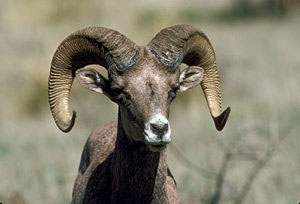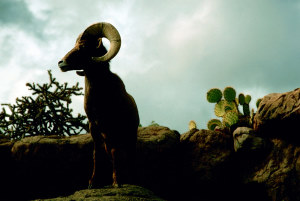Desert Bighorn Sheep (Ovis canadensis nelsoni)
Desert bighorn sheep was a favored prey animal for the native peoples of the Trans-Pecos. They are not as well represented in the archeological record as deer and antelope, however, because of their limited range in the region. They are well-adapted to the dry conditions and steep rocky slopes of the mountains of the Trans-Pecos, and only reside here. Their remains have, therefore, only been recovered from upland sites and rockshelters in the mountains, such as Fresnal Shelter.
Evidence of the importance of desert bighorn sheep to the native peoples of the Trans-Pecos resonates beyond the rocky mountain slopes, however, and can be seen in the rockart at Alamo Canyon and Hueco Tanks. There is also evidence that the horns of desert bighorn sheep were a popular trade item among the native peoples of the American Southwest. Hernán Gallegos, chronicler of the 1581-1582 Rodríguez/Chamuscado expedition, reported the discovery of an abandoned village north of La Junta that contained a very large cache of desert bighorn sheep horns meant for trade, each weighing an estimated 16 pounds.

The curving horns of desert bighorn sheep were a popular trade item among the native peoples of the Trans-Pecos and the greater American Southwest. Photo courtesy TPWD.
|
